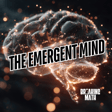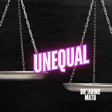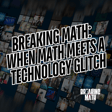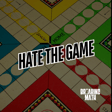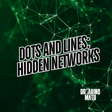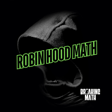Become a Creator today!Start creating today - Share your story with the world!
Start for free
00:00:00
00:00:01

22: Incomplet (Gödel, Escher, Bach: an Eternal Golden Braid: Chapter IV Discussion)
Gödel, Escher, Bach is a book about everything from formal logic to the intricacies underlying the mechanisms of reasoning. For that reason, we've decided to make a tribute episode; specifically, about episode IV. There is a Sanskrit word "maya" which describes the difference between a symbol and that which it symbolizes. This episode is going to be all about the math of maya. So what is a string? How are formal systems useful? And why do we study them with such vigor?
---
This episode is sponsored by
· Anchor: The easiest way to make a podcast. https://anchor.fm/app
Support this podcast: https://anchor.fm/breakingmathpodcast/support
Transcript
Tribute to Gödel, Escher, Bach
00:00:00
Speaker
Godela Escherbach is a book about everything from formal logic to the intricacies underlying the mechanisms of reasoning. For that reason, we've decided to make a tribute episode, specifically about Chapter 4. There is a Sanskrit word, maya, which describes the difference between a symbol and that which it symbolizes.
00:00:20
Speaker
This episode is going to be all about the math of Maya.
Introduction to String Theory and Formal Systems
00:00:24
Speaker
So what is a string? How are formal systems useful? And why did we study them with such vigor? All of this and more on this episode of Breaking Math. Episode 22, incomplete.
00:00:53
Speaker
I'm Jonathan. And I'm Gabriel. And today, obviously we're going to be talking about a chapter of Godel Escher Bach. And it's a great book. It's one of my favorite books. I remember reading it for the first time in college. Actually, I do want to say for the record, when we were planning out this podcast about a year ago right now, this was one of the books that came up. This was one of the books that you said we definitely want to talk about. So I am particularly excited that we get to talk about Godel Escher
Influential Books and Their Impact
00:01:21
Speaker
Bach on this one.
00:01:21
Speaker
What were some of the other books that we had mentioned? I think one of them was a book called Zero, the biography of a dangerous idea by Charles Sheef. That's a great one. What else? I am a strange loop. I think we've mentioned at one point also by the same author. Yeah. Douglas Hofstadter. Yeah. Yeah, absolutely. So a trivia time. The character in Big Bang Theory.
00:01:43
Speaker
is actually named after him, which makes me, I don't want to go into the politics of what that means, but there you go. Very nice. Very nice. But yeah, it's a tome. It's like 737 pages, but I want to pull it surprise. And it goes into like information theory, DNA, formal systems, neurology, self reference, the nature of meaning, obviously mathematics and, uh, very deeply into philosophy, but not in a way that's not
Self-reference in Mathematics, Art, and Music
00:02:08
Speaker
rigorous. And that's why I like it.
00:02:09
Speaker
Yeah, and actually, obviously it's rooted in mathematics. What I also love about this, and you kind of alluded to this, is that the title itself, Godel Escher Bach, is a mathematician, a musician, and an artist. And bringing those three together is just, it's beautiful is what it is. It's philosophical, it's deep.
00:02:27
Speaker
And they all have one thing in common, and that is self-referential systems. Godel, we'll talk about his stuff later, and it's all self-referential. We've talked about it in the past in several episodes, actually. Escher, he has a lot of self-reference and a lot of meaning changes. For example, there's the famous waterfall painting where water seems to flow down and then all of a sudden go up again, or people infinitely descending a staircase, things like that. And Bach wrote canons.
00:02:55
Speaker
Yeah, which we could play an example of a canon right here.
00:03:09
Speaker
And if you were astute, what you'd just noticed there was that all the voices were playing the same thing, but some of them were slower, some of them were upside down, some of them were backwards, and it takes a lot, a lot of effort to compose a canon. So that's kind of the essence of the book.
00:03:28
Speaker
I have a few younger listeners who I'm actually going to recommend this podcast to, and for our younger listeners who may not be familiar with what exactly self-reference means, how would you explain it to somebody in eighth grade? The word I. It's something that refers to oneself.
00:03:45
Speaker
Yeah, you can even do like a group of something.
Understanding Strange Loops and Self-reference
00:03:49
Speaker
So example, I happen to be male. So I could say all males eat macaroni and cheese. And I'm making a statement about myself, about other people too, but about myself. Now, would this be a good example? So if you have a book, you know, a dictionary and the dictionary, of course, has all the words in the English language or most of them, uh, the word dictionary within the actual dictionary.
00:04:10
Speaker
Yeah, that's a form of self-reference. It's not a strange loop because you can't keep going down and then end up where you started, like infinitely descending a staircase. Okay. But it is absolutely self-reference. So that's another key thing is not only self-reference itself, but also the other idea of strange loops. And you had mentioned it's something that can keep going and going kind of like a fractal, right?
00:04:35
Speaker
Oh yeah. Like, um, you just keep going and you end up started at, so, um, holding up two mirrors together. Is that an example? That's a little bit of an example. Let's see. Another example might be something like, uh, it's, it's difficult to come up with exact examples or strange loops. I mean, a Hofstadter argues in, I am a strange loop that consciousness itself is a strange loop. So it's not going to be something that I don't think we could go into too much into this podcast. Sure.
00:04:59
Speaker
But what we are going to be going into is all the things that we mentioned above. Self-reference, the nature of chapter four of this book, which happens to deal with axioms and isomorphisms. And I hope you enjoy this episode. In this episode,
Exploring Paradoxes and Logical Conundrums
00:05:16
Speaker
we will be delving into concepts, which Hofstadter explores in Godel asher Bach, chapter four. These include paradox, self-reference, and even Godel's incompleteness theorem. And we're going to be talking a little bit about formal systems and axioms, and we even have a dialogue for you directly borrowed from the book. We hope you enjoy this episode.
00:05:37
Speaker
So basically back a long time ago there was an isle called Crete, I guess it still exists, but there's this dude Epidemides from Crete and he said a famous statement, all Cretans are liars. Now is that statement true or false?
00:05:52
Speaker
That is a wonderful philosophical conundrum. And actually, I ran across that when I was in middle school. And that's the first time I was exposed to paradoxes like that. So let's break this down. If you say all Cretans are false. And you are Cretan. OK. And you are Cretan. That's a very important point. If it's true, then what you just said is false. Which then makes it true again. It flip-flops.
00:06:18
Speaker
What this is is a statement that is not a valid theorem in, I guess, just general common reasoning. Yes, it's very trippy. You try to pin it down and it just doesn't work. I mean, we can talk about this statement. And what's funny is when we talk about the universe, when we talk about physics and math, we have statements that describe the world around us. But this statement itself, as Jonathan just said, it just doesn't work.
00:06:44
Speaker
So how do we describe statements like these? And how do you describe to somebody why they just don't work? That itself is a problem that's been debated and is still debated. But the core of it is that it's something that's, I guess, neither true nor false, or in other words, it's not reachable. You can't start with a bunch of valid assumptions and then end up using logic with the statement, all cretins are liars. It's impossible to reach. It's the logical version of going cross-eyed.
00:07:14
Speaker
But what we're trying to do is figure out a math version of this.
Gödel's Incompleteness Theorem
00:07:19
Speaker
The purpose of this segment is to introduce Godel's incompleteness theorem. It might help to talk a little bit about what was going on in the world of math right before Godel published his theorem.
00:07:30
Speaker
Oh yeah, Hilbert was trying to develop what he called, I think, the math game or something like that, where you start out with one proposition and it branch out and somehow reach every provable and true, so I guess just every true theorem from this starting position. And there's actually a book by Whitehead and Russell called the Principia Matica, which attempted to form a basis for all math and Gotel just shattered it.
00:07:59
Speaker
Yeah, it was basically the ultimate mathematical tome. They just, it would have everything. It'd be the ultimate, all-encompassing book about mathematics. And the reason why Godel came and ruined it, how do we describe it? Godel essentially proved that mathematics, or rather any system of logic, will always, always be incomplete. If it's consistent, and if it's sufficiently powerful, which we will see.
00:08:26
Speaker
So basically what Godel said was that if you have any system that is consistent, in other words, it follows a set of rules and it is self-referential. Or can be. Or can be self-referential, then it'll always be incomplete. Or vice versa.
00:08:45
Speaker
Or if you've got a self-referential system that is apparently complete, it will be inconsistent. Basically what that means is that you either have a system where everything that's a theorem in that system is true, but not everything that is true is a theorem. So we'll give an example of this later. Or you have a system where everything
00:09:10
Speaker
that is true is a theorem, but not every theorem is true. You know, and one of the other things that can be said about this theorem is essentially it proved that at its foundation, mathematics will always rely on a set of axioms, or rather statements that can't be proven to be true. Those are just simple axioms. And a lot of people find this deeply troubling.
00:09:38
Speaker
Yeah, because some people aspire towards, for lack of a better term, godhood when it comes to mathematics. So we keep using this term theorem. What is a theorem?
Axioms, Theorems, and Truth in Mathematics
00:09:50
Speaker
Theorem. Okay, so I'm just gonna give you an off-the-cuff answer to your question. A theorem is a statement that is true about mathematics, and that is my off-the-cuff definition. See, that's almost on the money, but there's a very big difference between truth and theorem-hood. A theorem is any statement about mathematics.
00:10:11
Speaker
I'm going to play catch up here real quick. A theorem is any statement that is true about mathematics? No, any statement about mathematics. For example, the statement, all numbers are equal to three is a theorem.
00:10:25
Speaker
Okay. Okay. Got it. Got it. So it's a false theorem. Okay. So a theorem can be true or false and truth is a theorem that is true. How do you, how do you define what truth is without using the word true? Uh, you really can't. That's about the interpretation of the system.
00:10:42
Speaker
So that's self-referential almost. Yeah. Truth has to do with meaning. Theorems have to do with formal systems. And by formal system, we don't mean, like I've made this joke before, system with a tuxedo. But what we mean is a system where you have certain forms like shapes that, for example, the shape that looks like the number two, basically everything that you've learned in math
00:11:06
Speaker
Those can be considered symbols. And any theorem can be represented as a string of symbols. So let me give you an example of a string that's not a theorem. Plus plus plus equals plus plus. That doesn't mean anything.
00:11:20
Speaker
Okay, okay, I got it. Well, so in my mind here, I just imagined, you know, like a little, a little baby philosopher or a toddler philosopher asking his mom, mommy, what is truth? And then, and then, you know, an answer and I was seeing how mom would answer that question. I mean, that, that is a legitimate philosophical question and I admire your answer. So truth is kind of what is.
00:11:42
Speaker
Yeah, truth is what is with respect to a certain system. So let me give you an example. With the whole numbers, 7 divided by 4 is equal to a number is false because you cannot divide 7 by 4 with the whole numbers. With the real numbers or even the rational numbers, it's 7 fourths. So truth can also be consistency with an any given system.
00:12:06
Speaker
Truth is very closely rated consistency within any given system. That's not quite, this is a bugger of a definition. Oh yeah. So I know all of you guys just love definitions, and here's another one.
Isomorphisms and Meaning Across Transformations
00:12:19
Speaker
Isomorphism. What is an isomorphism? Let me take a whack at this real quick here. Isomorphism. Okay, let's break it down. So I know my Latin. So morph is change, is thing.
00:12:32
Speaker
Change thing, ISO, as in, okay, I'll give up, tell me. ISO actually means same and morph means shape or form. Okay. So an isomorphism is a transformation that you could do from one thing to another that preserves all of the original information.
00:12:52
Speaker
Okay, this is a really, really cool thing. And actually during the planning of this episode, we talked about this a lot. And I love the concept of isomorphisms. We even have an entire list of examples here. Jonathan, what was one of your favorite examples of an isomorphism? Well, I'm sure you've all made a cube out of construction paper at some point in elementary school. And so if you take a die, the surface of a die or any cube, really, I don't want you to think about the dots on the die.
00:13:22
Speaker
that is isomorphic to the unfolded piece of paper because you could transform it into another. So any dots on the cube can turn into a dot on this unfolded piece of paper. So in this case, the isomorphism is, as you just said, a cube or what it would look like when you unfold it in two dimensions. You've got a three dimensional version of the shape and you've got a two dimensional version of the shape and it has the same information in both of them.
00:13:47
Speaker
Yeah, and isomorphism itself is the transformation. And another isomorphism is between this MP3 file that you're listening to and the meaning that we're imbuing. Yes, now that gets a little more philosophical. I want to backtrack really quickly just because, as you had said, cube and paper, I thought of any origami shape. When you take any origami shape and you unfold it, and you can see all of the lines that went into the shape. That's essentially the two-dimensional version of the origami shape.
00:14:17
Speaker
Yeah. Yeah. And yeah. Yeah. Any origami figure is isomorphic to a square piece of paper. That's a great example. Yeah. So the, the meaning, would you say the meaning is preserved in an origami, let's say a crane and then you unfold it and it's a paper and you've got the same creases. The meaning is still there.
00:14:35
Speaker
The meaning is more about what's on top of what's being transformed. So like if I draw a heart on a swan that's been folded from a piece of paper and I unfold it, the heart is going to be somewhere on that piece of paper. So the heart didn't get lost. However, if we use scissors, we might cut off a piece of that heart and it's no longer an isomorphism if we cut off pieces.
00:14:56
Speaker
So that's the basic idea of an isomorphism. Now, as you had alluded to earlier, let's talk about a little bit of a deeper meaning. You had said one other isomorphism is this MP3 itself and the meaning behind it? Yeah, this podcast that you're listening to
00:15:12
Speaker
and the bits and bytes that are creating sound waves to your ear. So there's several isomorphisms there actually. There's the isomorphism between the sound waves that I'm experiencing right now and signals in the computer. Then there's an isomorphism between... Actually, it's not really an isomorphism because there's compression, but just bear with me.
00:15:32
Speaker
an isomorphism between that and the file we save it as, and then there's an isomorphism between that and what goes into your ear, and an isomorphism between what goes into your ear and what is understood with respect to English. Okay, so basically, yeah, as you just said, there's a whole lot right there in the underlying theme here. The underlying thing is the preservation of meaning.
00:15:55
Speaker
So when you talk about, just to go on the same thread of thought that you started, when you talk about an isomorphism between the lines and shape that comprise the letters of the alphabet and the meaning in a sentence, that's also an isomorphism.
00:16:10
Speaker
Cool. So do you think we have isomorphisms down? I am comfortable with isomorphism. I love that word and I love the concept. Sweet. So now we're going to talk about axiomatic systems and we're going to introduce a simple one. Every axiomatic system has symbols and this one has three symbols that we're going to care about.
00:16:27
Speaker
We appreciate you guys hanging in there with us. These are meaty, rich topics and they are so important for the theme of this episode as well as the book itself. So hang in there. This is some great discussion. So this is a system with one axiom plus equals and that has a meaning zero plus zero equals zero.
00:16:49
Speaker
or can have that meaning, you could have other meanings too. But if we interpret sequences of dots, so if we interpret dot dot dot as 3, then a theorem in the system might be dot dot plus dot dot dot equals dot dot dot dot, meaning 2 plus 3 equals 5. So basically what we're doing here is if previously we were defining terms like isomorphism, now we are defining rules that describe relationships in this system.
00:17:15
Speaker
Well, all we're doing right now is defining the axiom plus equals, and the rules themselves are more to do with the human brain than they are with anything, because math doesn't care about what we think of it. And actually, just plus equals being an axiom doesn't mean anything yet. It's the rules of inference that we're going to introduce right now that make it addition. So let's say that x, y, and z are sequences of dots.
00:17:39
Speaker
So x might be dot-dot, y might be dot-dot-dot, and z would obviously be five dots. If x plus y equals z is a theorem, then we have two rules of inference. Either x-dot plus y equals z-dot, or x plus y-dot equals z-dot. Both are true. So what does that mean? So that's obviously describing relationships here.
00:18:01
Speaker
So it means like if X is two dots, Y is three dots and Z is five dots, then we know that two plus three equals five, right? Yes. But if we know two plus three equals five, we also know that three plus three equals six and two plus four equals six. In fact, with these two rules of inference and the axiom plus equals, any sum of whole positive numbers can be demonstrated through the system. It can be proven that like seven plus 14 equals 21.
00:18:30
Speaker
This next section, we're going to talk about axioms and what they are and why they're important.
Analogies in Understanding Complex Concepts
00:18:35
Speaker
Now, since we're doing this about the Godelish or Bach chapter, I think that it would be appropriate for us to read a passage from the book.
00:18:43
Speaker
So in Godel Escherbach, he has a lot of dialogues. He considers himself a little bit of a dialogician. He always has the two characters Achilles and the tortoise. And he actually got those from a Lewis Carroll dialogue that was used to demonstrate a logical fallacy.
00:19:00
Speaker
How many of these little stories are there in Godel Escherbach? Oh, there's one for every single chapter. Awesome. Awesome. I love it. So it's a book that is a very deep book about a math concept, as well as art and meaning. And he starts everything with a lovely little narrative. So this is almost a first for breaking math. We've never really read a story aloud, have we?
00:19:19
Speaker
No, but just because of the nature of these dialogues, I think it'd be wonderful to expose our listeners to just one of them. Oh, definitely, definitely. Now, this particular story, there's a definite reason why we are reading this story. Should we explain to our listeners what they should look for in this story? Well, what you should look for is a second layer of hidden meaning.
00:19:44
Speaker
We're going to go explicitly into what the hidden layers are. But when a noun or any object appears in one of these stories, it tends to be a mathematical object. And it's kind of up to the reader to know what's going on. Yeah. And just to give you a quick preview, this story is about a phonograph, a record player. And it's also about perfection. And it asks the question, is it possible to have any sort of perfect phonograph? Without further ado, let's say we jump in.
00:20:13
Speaker
In this little radio opera, I'm going to be Achilles. And I will be the tortoise. Oh, and one interesting note before we start. In translations of the book, the tortoise is a female character because he wanted to unbiased himself against inherent sexism. Oh, wow. Yeah, so without further ado. Heavens, you certainly have an admirable boomerang collection. Ah, psh, no better than any other tortoise. And now, would you like to step into the parlor? Fine.
00:20:44
Speaker
I see that you have a large collection of records. What sort of music do you enjoy? Sebastian Bach isn't so bad, in my opinion, but these days I must say I'm developing more and more of an interest in a rather specialized sort of music. Tell me, what kind of music is that? A type of music which we're most unlikely to have heard of. I call it Music to Break a Phonograph By.
00:21:03
Speaker
Did you say music to break a phonograph by? That's a curious concept. I can just see you, sledgehammer in hand, whacking on phonograph after another to pieces, to the strains of Beethoven's heroic masterpiece, Wellington's Victory. That's not quite what this music is about. However, you might find its true nature just as intriguing. Perhaps I should give you a brief description of it? Exactly what I was thinking.
00:21:25
Speaker
Relatively few people are acquainted with it. It all began when my friend the crab, have you met him by the way? Paid me a visit. It would be a pleasure to make his acquaintance. Though I'm sure I've heard so much about him, I've never met him.
00:21:36
Speaker
Sooner or later, I'll get the two of you together. You had hit it off splendidly. Perhaps we could meet at random in the park one day. Capital suggestion. I'll be looking forward to it. But weren't you going to tell me about your music to smash phonograph by? Oh, yes. Well, you see, the crap came over to visit one day. You must understand, he's always had a weakness for fancy gadgets. And at that time, he was quite an aficionado for, of all things, record players.
00:21:59
Speaker
He had just bought his first record player, and being somewhat gullible, believed every word the salesman had told him about it. In particular, that it was capable of reproducing any and all sounds. In short, he was convinced that it was a perfect phonograph.
00:22:15
Speaker
Naturally, I suppose he disagreed. True, but he would hear nothing of my arguments. He staunchly maintained that any sound was reproducible on his machine. Since I couldn't convince him of the contrary, I left it at that. But not long after that, I returned the visit, taking with me a record of a song which I myself had composed. The song was called, I cannot be played on record player one.
00:22:37
Speaker
rather unusual. Was it a present for the grab? Absolutely. I suggested that we listen to it on his new phonograph, and he was very glad to oblige me. So he put it on. But unfortunately, after a few notes, the record player began vibrating rather severely, and then with a loud pop, broke into a large number of fairly small pieces, scattered all about the room. The record was utterly destroyed, also, needless to say. Calaminous blow for the poor fellow, I'd say. What was the matter with this record player?
00:23:02
Speaker
Really, there was nothing to matter, nothing at all. It simply couldn't reproduce the sounds on the record which I had brought him because the sounds would make it vibrate and break. Odd, isn't it? I mean, I thought it was a perfect phonograph. That's what the salesman had told him, after all. Surely, Achilles, you don't believe everything that salesmen tell you. Are you as naive as the crab was?
00:23:20
Speaker
The crab was naive by far. I know that salesmen are notorious prevaricators. I wasn't born yesterday. In that case, maybe you can imagine that this particular salesman had somewhat exaggerated the quality of the crab's piece of equipment. Perhaps it was indeed less than perfect and could not reproduce every possible sound. Perhaps that is an explanation.
00:23:38
Speaker
But there's no explanation for the amazing coincidence that your record had those various sounds on it. Unless they got put there deliberately. You see, before returning the crab's visit, I went to the store where the crab had bought the machine and I inquired as to the make. Having ascertained that, I sent off to the manufacturers for a description of its design. After receiving that, by return mail, I analyzed the entire construction of the phonograph and discovered a certain set of sounds which, if they were produced anywhere in the vicinity, would set the device to shaking and eventually to falling apart.
00:24:06
Speaker
Nasty fellow, you needn't spell out for me the last details, that you recorded those sounds yourself and offered the dastardly item as a gift. Clever devil, you jumped ahead in the story, but that wasn't the end of the adventure by any means, for the crab did not believe that his record player was at fault. He was quite stubborn, so he went out and bought a new record player, this one even more expensive, and this time the salesman promised to give him double his money back in case the crab found a sound which it could not reproduce exactly. So the crab told me excitedly about his new model, and I promised to come over and see it.
00:24:36
Speaker
Tell me if I'm wrong. I bet that before you did so, you once again wrote the manufacturer, and composed and recorded a new song called I Cannot Be Played on Record Player 2, based on the construction of the new model. Out of the brilliant deduction Achilles, you've got quite the spirit. So what happened this time? As you might expect, precisely the same thing. The phonograph fell into innumerable pieces, and the record was shattered. Consequently, the crab became convinced that there could be no such thing as a perfect record player.
00:25:01
Speaker
Mmm, rather surprisingly, that's not quite what happened. He was sure that the next model would fit the bill, and having twice the money he- Oh! I have an idea! He could easily outwitted you by obtaining a low fidelity phonograph, one that was not capable of reproducing sounds which would destroy it. In that way, he would avoid your trick.
00:25:18
Speaker
Surely, but that would defeat the original purpose, namely to have a phonograph which could reproduce any sound whatsoever, even its own self-breaking sound, which is of course impossible. That's true. I see the dilemma now. If any record player, say record player X, is sufficiently high fidelity, then when it attempts to play the song, I cannot be played on record player X. It will create just those vibrations which will cause it to break, so it fails to be perfect.
00:25:44
Speaker
And yet, the only way to get around that trickery, namely for record player X to be of lower fidelity, even more directly ensures that it is not perfect. It seems that every record player is vulnerable to one or the other of these frailties, and hence all record players are defective. I don't see why you call them defective. It's simply an inherent fact about record players that they can't do all you might wish them to be able to do. But if there's a defect anywhere, it's not in them, but in your expectations of what they should be able to do, and the crab was just full of such unrealistic expectations.
00:26:14
Speaker
Compassion for the crab overwhelms me. High fidelity or low fidelity he loses either way. And so our little game went on like this for a few more rounds and eventually our friend tried to become very smart. He got wind of a principle upon which I was basing my own records and decided to try to outfox me.
00:26:30
Speaker
He wrote to the phonograph makers and described a device of his own invention, which they built to specification. He called it Record Player Omega. It was considerably more sophisticated than an ordinary record player. Let me guess how? Did it have no moving parts? Or was it made of cotton? Or... Let me tell you instead. That will save some time.
00:26:48
Speaker
In the first place, record player Omega incorporated a television camera whose purpose it was to scan any record before playing it. This camera was hooked up to a small, built-in computer which would determine exactly the nature of the sounds by looking at the groove patterns.
00:27:01
Speaker
Yeah, so far so good. What could record player Omega do with this information? By elaborate calculations, its little computer figured out what effects the sounds would have upon the phonograph. If it deduced that the sounds were such that they could cause the machine in its present configuration to break, then it did something very clever. Old Omega contained a device which would disassemble large parts of its phonograph subunit and rebuild them in new ways so that it could, in a
00:27:26
Speaker
In fact, change its own structure. If the sounds were dangerous, a new configuration was chosen, one to which the sounds would pose no threat. And this new configuration would then be built by the rebuilding subunit under direction of the little computer. Only after this rebuilding operation would record player Omega attempt to play the record. Aha! That must have spelled the end of your tricks. I bet you were a little disappointed. Curious that you would think so. I don't suppose you know Godel's incompleteness theorem backwards and forwards, do you?
00:27:53
Speaker
Knows whose theorem backwards and forwards? I've never heard of anything that sounds like that. I'm sure it's fascinating, but I'd rather hear more about music to break records by. It's an amusing little story. Actually, I guess I could fill in the end. Obviously, there's no point going on, so you sheepishly admit a defeat, and that was that. Isn't that exactly it? What? It's almost midnight. I'm afraid it's my bedtime. I'd love to talk some more, but really, I'm growing quite sleepy. And that's about half of the story. The rest of it is unnecessary for the purposes of what we're doing.
00:28:21
Speaker
Can we say something along the lines of, uh, don't take my word for, I can't finish that cause it's copyrighted. We could because you are out of employment. Yes. But, uh, and the gist of it and.
00:28:37
Speaker
Further on in the book, you learn that there are certain records for which the record player Omega cannot reconfigure itself to be able to play. So even with this amazing, complicated device, you still get unplayable records.
00:28:54
Speaker
So by its nature, it is always incomplete. Even though it could reproduce some sounds perfectly, it can't reproduce all sounds perfectly by the very nature of existing in a situation where, I guess in this analogy, the direct thing would be resonance. If you sing a certain note, a wine glass will break if you're in a cartoon. Didn't we talk about that on the frequency episode, I think? I believe we did. Yeah, I'll check out that episode. It's a good one.
00:29:21
Speaker
So in this story, Hofstadter points out some parallels that I'm sure that anybody studying mathematics would be able to deduce for themselves. And for those who don't study mathematics formally, then we'll be happy to explain on this podcast. Let's go term by term. A phonograph, what's a phonograph in this system? Actually, for our younger listeners, a phonograph is something that plays records. But what is a phonograph in the story?
00:29:47
Speaker
So it's symbolic. A phonograph is symbolizing an axiomatic system for number theory. The phonograph is the thing that turns things like 2 plus 2 equals 4 into 2 plus 3 equals 5. So the phonograph is kind of like the machine. It's got a set of rules, it's got functions, and following the axioms you can have predictable outputs.
00:30:11
Speaker
And the sounds that a phonograph produces are true statements. And that's the gist of what the phonograph is, but there's several other pillows that we could draw it as well. I think later in the story, in fact, I think it was Achilles was suggesting that the tortoise, or rather that the crab had pointed out that a low fidelity phonograph would solve the riddle.
00:30:35
Speaker
The low-fidelity phonograph is a weak, quote-unquote, weak axiomatic system, which is a system you learn later in the book that cannot refer back to itself even indirectly. Okay. So again, the topic of self-reference is huge in this book. And then just for the purpose of this discussion, a weak system is a system that cannot refer to itself. Do we have any other examples to illustrate?
00:30:59
Speaker
An example of a weak system would be the addition axioms that we had earlier. There's no way of reproducing rules of logic within that system. There's no formula. Because as we'll see, even though you can turn any theorem into a number, you cannot manipulate that number
00:31:19
Speaker
in the way that the math, it's not self-referential, it's basically low fidelity.
Axiomatic Systems in Mathematics
00:31:25
Speaker
Okay, very good. And high fidelity is the opposite. High fidelity is self-referential. Yes, and of course there's all kinds of math, especially in the realm of proofs with Godel that specifically address high fidelity, strong mathematical systems.
00:31:38
Speaker
A strong system is required for complete number theory, like really, because number theory, it includes statements like the prime numbers are innumerable. That's a statement of number theory. So number theory is basically everything that you think about math. So it has to be, so it almost has to be self-referential. Attempts were made up to 1931 to try to get rid of self-reference in number theory. And, but then Godel publishes proof and dashed everyone's hopes.
00:32:07
Speaker
Yeah, for eternity. That's probably one of the most profound proofs of all time. Oh, yeah, it's a proof about paradox itself and the limits of reason. Which brings us to our next topic. The crux of the story is how a perfect phonograph, quote unquote, would operate. And this, of course, stands for a complete system for number theory, which we said simply does not exist.
00:32:28
Speaker
Yeah, so if a phonograph is a system for number theory, a perfect phonograph is a complete one that we just described. And when the tortoise wrote to the manufacturers for the blueprint, those just are the axioms and rules of the system. So the building blocks basically.
00:32:46
Speaker
There's quite a few parallels here. Also, a record in a story is what? A string. And by string, we mean something that you write down. It's the difference between a number and a numeral, basically. A numeral can be part of a string, but a number would be part of a theorem. So a string is just a way of representing theorems. So the grooves on the record basically represent something that can be interpreted.
00:33:15
Speaker
And if it's playable at all, then it's a theorem. OK. And if it's unplayable, of course, that would be a non-theorem. And then, of course, that gets into sound itself. A sound from the phonograph would be a true statement of number theory.
00:33:29
Speaker
Yeah, and I would like to say that a non-theorem is not the same as a non-truth. A non-theorem is with respect to the phonograph itself. So a non-theorem means something that can't be derived from axioms, basically. You can't logically start with a series of assumptions and arrive at this, even though it may be perfectly true. And there are examples of true statements in number theory
00:33:53
Speaker
that cannot be derived using, for example, piano or arithmetic, which we covered on the episode about day-to-day math. Hit Tune to the Hickory Stick. In fact, there's even one more here that we highlighted in this section. The statement, I cannot be played on record player X. That's the title of the song. And what parallel does that have in the real world? I cannot be derived in formal system X. So that's the crux of it.
00:34:20
Speaker
That's just the title of the record. And that's just in the same way that the second one isn't really a mathematical formulation, but it's a way it is a mathematical formulation, but it's, it's a direct parallel. So hopefully we beat this analogy to death.
00:34:36
Speaker
You know, after we're going through it, of course, Hofstadter chose this analogy of a record player, but I think there are countless analogies you could do. Any device that has a specific output you could do, maybe for a writing exercise, one could think of another analogy other than record players to explain this concept with. In fact, and don't Google this before you do it, but there is a proof of Godel's theorem that can be done with the analogy of a fax machine.
00:35:05
Speaker
We're not gonna give you that answer because you'll pat yourself on the back so much when you discover that. And like the tortoise said, this is only disappointing if you have unrealistic expectations of formal systems. It doesn't destroy reality, it's not a crisis. It just means that not every formal system can do all of math and we're gonna have to always improve on our formal systems. It's almost like the game kind of never ends, you know?
00:35:28
Speaker
Yeah, which, which I think is, I mean, there's no, I'm going to wax philosophical for a second. There's no real point to life. And what meaning we derive from life is derived from the activities that we do within it. And if mathematics can be beautiful, then knowing that this beauty will never run out to me is actually a better result than if we had some machine that can drive all of math for us.
00:35:53
Speaker
Is this at all related to the P equals NP? P equals NP problem? Yes. It might have some isomorphisms, but none that I'm aware of. I like how you use that word. That's the word of the day. Also, it's worth pointing, when you said that life has no meaning, it's not that it's meaningless, it's that it's like one specific meaning. Yeah, that's what I mean. Yeah, life has no, there's no one lens through which you can view all of life. And in the same way that there's no one axiomatic system, they can view all of mathematics.
00:36:24
Speaker
If you're enjoying this episode and love studying not only paradoxes, but the mechanisms behind them, you're going to want to be comfortable with logic. And if you're not 100% confident, then I'd like to point you towards Brilliant.org. Their course on logic makes it fun and easy for you to start thinking logically and manipulating complex propositions. As part of every form of math, why not work through the course in just a few days? In particular, the chapter Syllogism and Sets has a lot to do with the concepts that we go into in this episode.
00:36:53
Speaker
So if you're at a computer, go to brilliant.org slash breakingmath, click on their courses, select logic, and select the last chapter, so the legitimate sets. That's brilliant.org slash breakingmath. Not only are you directly supporting the show, but the first 200 breakingmath listeners will get 20% off of the annual subscription that we've been using. And now, back to the show.
00:37:16
Speaker
So now we're gonna go visit our old friend Euclid again, who, as you may recall from an earlier episode, was one of the founders of rigorous mathematics and developed one of the first, or the first, I'm not totally sure about that, systems of axioms. And even though it's criticized today for not being very rigorous, assuming that the person knows what a point is and not being formal, it's still an axiomatic system. And it's a good example of one.
00:37:46
Speaker
and so we're gonna give you the five postulates. Now, I think we've touched on this in any previous episode. I don't recall which one it was, if it was one of our earlier. I can't recall at this point. It might have been on the episode about Prus, QED Prove It. Perhaps, yeah. And the point of this being that the fifth postulate is uglier than the other four, and we'll run through them real quick just to show you why.
00:38:12
Speaker
Yeah, and besides, it's always awesome to review Euclid. He's great, so. Even if we've already visited this before. Oh yeah, The Elements is like a thousand page book that uses five assumptions. It's amazing. Yeah. First postulate, a straight line segment can be drawn, joining any two points.
00:38:29
Speaker
So you could draw a line between two points, no arguments there. Nope. Any straight line segment can be extended indefinitely in a straight line. So if you lay out, you have a pencil, you could, or, or a, uh, what do you call them? A laser pointer. The laser pointer extends the line that the laser pointer is.
00:38:47
Speaker
Third one says, given any straight line segment, a circle can be drawn having the segment as a radius and one end point as the center. Meaning that you, if you have like a pencil or something, you can hold the eraser against the paper and move the lead around and make a circle. It's pretty self-explanatory. I've done that with string as well. All right angles are congruent. And that just means that if two things happen to be right angles, then they're the same angle.
00:39:14
Speaker
And then the ugly pa shilde, the fifth one. Here goes. If two lines are drawn which intersect a third in such a way that the sum of the inner angles on one side is less than two right angles, then the two lines inevitably must intersect each other on that side if extended far enough. Oh my goodness, that's like a kid who tells you a story that goes on and on and on.
00:39:36
Speaker
Oh, yeah. And so to break that down, I mean, what it means is if two lines are not parallel, then they're going to intersect. And you tell that they're parallel by looking at the sum of the interior angles with a third line intersecting it. It's something that we can't really do without the other ones. We could tell you what they meant. But this third one really does require a diagram. And you could tell that
00:40:00
Speaker
Euclid didn't like it because for the first several things that he proves, he ignores it and he ignores it whenever he possibly can. And people for hundreds and hundreds of years tried to prove it using the other four postulates. And they have not proven it yet. And in fact, it is unprovable because you get perfectly valid and consistent mathematics by
00:40:23
Speaker
eliminating or modifying it. And for example, Girolami Sakheri, who lived from 1667 to 1733, did a bunch of math that involved trying to prove the fifth with the other four. And he reached a proposition that he was like, okay, this is repugnant to the nature of the straight line. And then he's like, fine, Euclid is freed of every flaw. And he wrote a book called Euclid, Freed of Every Flaw, or Eukladys ab omni
00:40:56
Speaker
which has kind of a sense of being vindicated. It's a very aggressive title. Sounds like quite a fan of Euclid. Oh, yeah. I mean, who isn't? Well, of course, he had some very significant findings, and there was a lot to this. It sort of opened the door to a whole new kind of mathematics.
00:41:12
Speaker
Oh yeah, for example, hyperbolic geometry and elliptical geometry. You might know from class that if you take a triangle and you snip off the ends of the triangle, so you snip off three little triangles from the triangle, and you put them together, you'll get a straight line. So the sum of the interior angles of a triangle add up to 180 degrees is the math way of saying that.
00:41:39
Speaker
But in a hyperbolic geometry, it's less than 180 degrees. Now, isn't that kind of the exact same thing as Euclid's fifth postulate? Because with a triangle, you have that, well, I guess not necessarily. I believe with the other four, and with that assumption, you can derive the fifth postulate, but you have to have that assumption. So it's just like having a postulate itself, and it doesn't really help everything.
00:42:01
Speaker
And actually, I realized in my head, no, I'm totally wrong. Because also, if you have two lines that are, in fact, parallel, if they're not parallel, you can. If they are parallel, then you can't make a triangle. All that does is you start with lines that are not parallel.
00:42:14
Speaker
And J.H. Lambert tried doing this too, as did his father, and their correspondences are actually really funny. We don't have time to go into them, but they're very dramatic about wanting to prove the fifth postulate. And after a while, people were like, okay, fine, there's two new types of geometry, or two plus new types of geometry from this new thing. And to illustrate spherical or
00:42:38
Speaker
Elliptical geometry, all you have to do is redefine things a little bit. You define a point as a pole and its anti-pole. So, for example, the North Pole and the South Pole on the Earth, or the United States and the middle of the Pacific Ocean.
00:42:55
Speaker
So that is considered a point, which would normally be considered two points, but we're redefining what a point is. And then we redefine a line as the great circle, and a great circle is just a circle that has the same radius as the sphere. You could do all kinds of geometry with that. In fact, every single thing that Euclid proved that didn't require the fifth postulate works in hyperbolic and spherical geometry.
00:43:21
Speaker
In fact, isn't there a brilliant.org course on geometry that touches on this a bit? So what you should take away from this, the discovery of two different types of mathematics, from the modification of an axiom, is that axiomatic systems can have flaws in them, or not just flaws, but they could cover up
00:43:42
Speaker
beauty that you would not otherwise find. Essentially, by changing an axiom, we discovered, or the gentleman who we, who we, um, mentioned, uh, Girolamo Sakary, Girolamo Sakary. Excellent. I'm working on my pronunciation here. So basically we, we learned that, uh, by changing an axiom, Girolamo, Girolamo Sakary introduced us to a brand new form of geometry that wouldn't have otherwise existed.
00:44:06
Speaker
even though he didn't know he did it and he didn't use it very much because there's certain things that you prove in elliptical and hyperbolic geometry that you can't prove in
00:44:18
Speaker
normal Euclidean geometry, and if only he knew what he discovered. You know, the way you describe him, you describe him as somebody like holding a garage sale who's just selling an old pair of golf clubs for 20 bucks, even though they're worth like hundreds of thousands of dollars and he just didn't really know it. Yeah, and they belong to, I can't think of a famous golfer. Golf clubs that belong to the original Euclid, with all of his lines. He did all of his proofs on the golf course. Euclid was an avid golfer.
00:44:49
Speaker
That'd be awesome. Do a little cartoon of all of Euclid's proofs just with golf. So now we're going to talk a little bit about consistency and completeness.
Consistency and Completeness in Formal Systems
00:45:02
Speaker
A system that is consistent means that everything that's a theorem in that system and a theorem, remember, is something that could be derived from axioms is true.
00:45:11
Speaker
An example of this is Euclid. Everything that you can prove using Euclid's geometry is true. Something that you cannot prove using Euclid's geometry, though, is that a angle can be trisected, for example, which is something that you could do with paper folding, which is a different axiomatic system entirely. Consistency is with respect to the formal system. So let's say there's a biologically consistent system.
00:45:38
Speaker
Can you give an example of a theorem and a non-theorem in, not a non-theorem? Biologically consistent system? Wow, okay. So in a system that's consistent, like for example, biologically, give an example of something that's a theorem that might as well be true or false and in a theorem that cannot be derived in that system.
00:46:00
Speaker
Oh wow. Okay. Okay. So something that could be true or false, but can't be derived from a system. Okay. Are we still doing biology here? So consistency has to do with the subject matter involved. So let's say we had a formal system about biology. What's a theorem that could exist in biology? Maybe it doesn't have a true or false value, but it could exist.
00:46:20
Speaker
Okay, sure. So without any true or false value, for instance, you could say that in a biologically consistent system, there could be a theorem whose interpretation is the statement Shakespeare wrote in opera. But no theorem whose interpretation is the statement, sell less animals exist.
00:46:36
Speaker
Yeah. And, um, this is an example taken directly from Godel asher Bach. And another thing that he brings up in this thing has to do a little bit with consistency is all math the same. So like one plus one should always equal two, right? Yep. And there should always be an infinite amount of primes, right? Indeed.
00:46:53
Speaker
And all writing should be congruent, right? Yes. And possibly that five should always be true, right? Except for as we just discussed, for those who are paying attention, should be, but really isn't. So the question is, where is the line? And the answer is, we don't know yet. We're making leaps and bounds, but the arts of axiomatic systems in the context of Godel's theorem is only something like 87 years old.
00:47:17
Speaker
Indeed. So to actually quote Rick Sanchez from Rick and Morty, he says, sometimes Morty, science is more of an art than a science and people don't realize that, except for in this case, mathematics. It feels like that when you're talking about Godel. And then there's completeness. And completeness means that everything that is true
00:47:37
Speaker
is a theorem. Now remember, consistency, everything that is a theorem is true versus everything that is true is a theorem. There's a very subtle but very big distinction between these two. In an incomplete system, what we're saying is that something could be true but could not be a theorem. And why could something be true but is not a theorem? Because it could just be true within the assumptions of like, for example, number theory.
00:48:03
Speaker
but it might not be a theorem because it might not be able to be derived from the basic assumptions. So, for example, it is true that 0 plus 5 equals 5, but if you use a number system which starts at 1, then you can never prove that because there's no 0, basically. That's contrived in many ways erroneous example, but that's the best one I could give.
00:48:27
Speaker
And an inconsistent system, remember consistency, everything that is a theorem is true, means that some theorems are false, meaning that the system is basically worthless. Yep. If you've got false theorems in there, that's a worthless system. And I think that it bears talking about the fact that every system that can really refer to itself or that is sufficiently powerful has to have negation.
00:48:55
Speaker
as a thing, or at least non-theorems. For example, P and not P is a famous example of something that's always false. So true and false is false, or false and true is false. But if we interpret the symbols differently, so for example, if we used the expression is for not,
00:49:17
Speaker
then P equals is P, it would be perfectly valid. So we have to have non-theorems as well, but that's a little bit more complicated. So in essence, to sum that up, we've got completeness and we've got consistency. And so if a system is consistent, then it can never be complete, is that right? It's a sufficiently powerful system. Okay. A sufficiently powerful system can either be inconsistent and complete,
00:49:45
Speaker
or incomplete and consistent. Or it could be just neither, but nobody studies those. I'm probably putting my foot in my mouth. There's probably people who study those. So now we're going to talk real quick about
Gödel Numbering and Mathematical Isomorphisms
00:50:00
Speaker
Godel numbering. So remember the dots plus equals thing that we talked about earlier. So real quick, just to give a little primer. So what can we expect with Godel numbering? Why, why, why, why did Godel decide to introduce a numbering named after himself? Somebody else named it after him, but he, uh, that's at least less arrogant now the way I explained it, but it's, it's a way of turning theorems into numbers because think about it. If we have a function,
00:50:30
Speaker
that takes in a Godel number and outputs the truth value of it, then that's a very powerful tool. So it allows number theory to make statements about itself. And all it requires is a very simple numbering scheme. Godels is more complicated than the one that we're going to be talking about. So let's say we have the theorem dot dot dot plus dot dot equals dot dot dot dot dot. That's not Morse code.
00:50:58
Speaker
Note that corresponds to three plus two equals five. Corresponds to not is, big distinction. So if we let dot equal one plus equals two and equals be represented by three, then we get this number 111,211,311,111 that represents a true theorem. Now does this bring us back to the term isomorphism that we were talking about earlier? Absolutely, yeah, this is another isomorphism.
00:51:26
Speaker
I don't know. I'm just on the ball with bringing it back. So yeah, the Godel function takes in theorems and outputs numbers. And the reason why we want to be able to do this is because you could think of this as quoting. So if we have a theorem, let's call it T, the Godel number of T is like T in quotes. And if we took the Godel number of that, that would be that even further in quotes. Whoa, whoa, whoa. It's like inception here. So the Godel number of a Godel number.
00:51:52
Speaker
Yeah, you could keep doing that indefinitely. Key in quotes. Okay, okay. So, all right. And the reason why we want to be able to do this is because of a paradox that refers to itself without using the words I or this. And what is that paradox that we have mentioned on the show before?
00:52:12
Speaker
Okay. Oh, this is a fun little paradox. All right. So in quotations, preceded by its quotation yields falsehood and quote preceded by its quotation yields falsehood. So we have this little thing preceded by its quotation yields falsehood and that describes an operation. So the sentence refers to itself and the sentence like this, like the eponymity is paradox is neither true nor false.
00:52:37
Speaker
That's kind of the same thing as the Crete one, right? Where if you're from Crete, all Cretans are liars. Is that true or is that false? The reason why this one's special is because it doesn't require any special self-referential symbols. It just requires quotation. In a lot of sci-fi, isn't that how the heroes
00:52:59
Speaker
will defeat a super intelligent, like, super computer by asking if that statement is true or false? Yeah, I mean, you could defeat Google in the same way. You just Google, when Googled breaks Google, no, you can't do that. I tried to try and I failed. When Google breaks Google. There should be some sort of self-referential Google search. Can't there be? That's an exercise for our listeners. What happens when Google searches for itself? Has Google found itself? Does Google know what Google is?
00:53:27
Speaker
Thank you Google for letting us reference you.
Future of Mathematics and Axiomatic Systems
00:53:31
Speaker
Formal systems are the pillars upon which mathematics rest. But these pillars had to be constructed by someone or something. And whether or not that thing is truth is something that we've yet to find out. And the more we know about these pillars and the labyrinthine structures that were formed on top of them, the more that we'll know about how to construct mathematics in the future. We'd like to give a special thanks to Douglas Hofstadter for writing the chapter of the book that inspired this episode. I'm Jonathan. And I'm Gabriel. And this has been Breaking Math.
00:54:07
Speaker
Now we're going to talk to you a little bit about an offer we have going on. That's right. We have a Patreon account which you can reach at www.patreon.com slash breakingmath and we have a few new goodies up there. That's right.
00:54:22
Speaker
Poster that I worked very hard on that explains tensor mathematics Technically from start to finish. It's more of a it's a review sheet a very big review sheets I believe is 24 by 36 inches, but yeah, it'll introduce you to tensors has some commonly used formulas on it So if you're doing anything with general relativity
00:54:44
Speaker
or even certain types of engineering, you might want to get that. Or if you know anybody who is really into Einstein, this would be a perfect gift for them. Yeah. And I just want to point out that it's a very unique poster because a lot of folks, this day and age, a lot of folks will study the mathematics of special relativity, but not a lot of people that I know are studying the mathematics of general relativity. So for that reason, this poster is a really great introduction to the topic.
00:55:09
Speaker
Yeah, and I wrote this sort of as I was studying general relativity, and it contains everything that I wish that I would have been told directly.
00:55:20
Speaker
Yeah, so it's an awesome, awesome thing that you made and I'm sure that there's a lot of folks out there who would really appreciate your work. And of course we have other prizes on Patreon.com such as Breaking Math Silver and Breaking Math Gold where you could either get a shout out on the podcast or you could have access to the outlines before the episodes are out. So if that's anything that you would like to do or if that's something that you kind of want to do but you really want to support us,
00:55:45
Speaker
We would absolutely love it and yeah, just the price of a fancy cup of coffee. We love your support and considering us. We have a lot of big plans for this channel. We'd love to have a YouTube show where we can show visuals. We also have a series of other educational podcasts, much in the same spirit of breaking math to do.
00:56:03
Speaker
Not to give away too much information about our listenership, but we're reaching a point now where it makes sense for us to give you guys even more of what you already love. Yeah, yeah. And it is, of course, our dream eventually to do this full time. And if you want to help make that dream possible, boast our time. We are greatly, yes, we'd be greatly appreciative of that. To which you can reach at www.patreon.com slash breakingmath.




